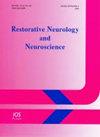小脑tDCS和任务导向回路训练对多发性硬化症患者的联合作用:一项初步随机对照试验。
IF 1.6
4区 医学
Q4 NEUROSCIENCES
引用次数: 4
摘要
背景:平衡和活动障碍在多发性硬化症患者中很常见,部分原因是小脑功能障碍。以任务为导向的行为方法先前被证明可以促进身体机能。在训练过程中应用的小脑经颅直流电刺激(ctDCS)有可能增加大脑的兴奋性,通过调节小脑-脑抑制来促进康复效果。目的探讨小脑ctDCS刺激联合运动训练对多发性硬化症患者活动能力和平衡能力的影响。方法在一项双盲随机临床试验中,16名受试者每天随机接受真实或虚假ctdcs和任务导向训练,持续两周。在治疗前后和两周的随访中测试了功能活动能力、平衡能力、步行表现和生活质量。同时记录了小脑刺激对心理和执行功能的影响。结果两组患者治疗后行走能力、平衡能力和生活质量均有改善,并在随访2周后保持。双向方差分析显示,平衡和步行表现存在显著的时间效应。时间处理的交互作用显著(F = 3.12, df = 2,26;p = 0.03)在接受real-ctDCS患者生活质量评估的运动方面发现。结论任务导向训练可改善多发性硬化症患者的平衡和活动能力,但ctDCS不能提高运动训练的效果。本文章由计算机程序翻译,如有差异,请以英文原文为准。
Combined effects of cerebellar tDCS and task-oriented circuit training in people with multiple sclerosis: A pilot randomized control trial.
BACKGROUND
Balance and mobility impairments are frequent in people with multiple sclerosis, partly due to cerebellar dysfunctions. Task-oriented behavioural approaches were previously shown to promote physical function. The possibility exists that cerebellar transcranial direct current stimulation (ctDCS) applied during training, known to increase the excitability of the brain, can boost rehabilitation effects through modulation of cerebellum-brain inhibition.
OBJECTIVE
To test the efficacy of cerebellar ctDCS stimulation combined with motor training on mobility and balance in people with multiple sclerosis.
METHODS
16 subjects were randomly assigned to receive real- or sham-ctDCS and task-oriented training daily over two weeks in a double-blind, randomised clinical pilot trial. Functional mobility, balance, walking performance and quality of life were tested before and after treatment and at two-week follow-up. Effects of cerebellar stimulation on psychological and executive functions were also recorded.
RESULTS
Walking performance, balance and quality of life improved for both groups at post-treatment assessment which was maintained at 2-weeks follow up. A two-way ANOVA revealed a significant time effect for balance and walking performance. A significant interaction effect of time-treatment (F = 3.12, df = 2,26; p = 0.03) was found for motor aspects of quality of life assessment in patients who received real-ctDCS.
CONCLUSIONS
Task-oriented training improves balance and mobility in people with multiple sclerosis, but ctDCS does not boost motor training effects.
求助全文
通过发布文献求助,成功后即可免费获取论文全文。
去求助
来源期刊
CiteScore
5.40
自引率
3.60%
发文量
22
审稿时长
>12 weeks
期刊介绍:
This interdisciplinary journal publishes papers relating to the plasticity and response of the nervous system to accidental or experimental injuries and their interventions, transplantation, neurodegenerative disorders and experimental strategies to improve regeneration or functional recovery and rehabilitation. Experimental and clinical research papers adopting fresh conceptual approaches are encouraged. The overriding criteria for publication are novelty, significant experimental or clinical relevance and interest to a multidisciplinary audience. Experiments on un-anesthetized animals should conform with the standards for the use of laboratory animals as established by the Institute of Laboratory Animal Resources, US National Academy of Sciences. Experiments in which paralytic agents are used must be justified. Patient identity should be concealed. All manuscripts are sent out for blind peer review to editorial board members or outside reviewers. Restorative Neurology and Neuroscience is a member of Neuroscience Peer Review Consortium.

 求助内容:
求助内容: 应助结果提醒方式:
应助结果提醒方式:


